Paleoenvironment of the Lower–Middle Cambrian Evaporite Series in the Tarim Basin and Its Impact on the Organic Matter Enrichment of Shallow Water Source Rocks
Abstract
:1. Introduction
2. Geological Setting
3. Materials and Methods
3.1. Samples
3.2. Experimental Methods
3.2.1. TOC
3.2.2. Major Elements
3.2.3. Trace Elements
4. Results
4.1. Petrology
4.2. Organic Matter Content
4.3. Organic Matter Type
4.4. Major Elements
4.5. Trace Elements
5. Discussion
5.1. Lithologies, Facies, and their Meaning in the Paleoenvironment
5.2. Paleosalinlity and Its Implication for Organic Matter Enrichment of Shallow Water Evaporitic Environment
5.3. Redox Proxies and Its Implication for Organic Matter Enrichment of Shallow Water Evaporitic Environment
5.4. Paleoproductivity and Its Implication for Organic Matter Enrichment of Shallow Water Evaporitic Environment
5.5. Paleoclimate and Its Implication for Organic Matter Enrichment of Shallow Water Evaporitic Environment
5.6. Paleo-Seawater Depth and Its Implication for Organic Matter Enrichment of Shallow Water Evaporitic Environment
5.7. Factors Controlling Organic Matter Enrichment and Its Implications for Organic-Rich Source Rock Prediction
6. Conclusions
Author Contributions
Funding
Data Availability Statement
Acknowledgments
Conflicts of Interest
References
- Hite, R.J.; Anders, D.E. Chapter 4 Petroleum and Evaporites. In Developments in Sedimentology; Melvin, J.L., Ed.; Elsevier: Amsterdam, The Netherlands, 1991; Volume 50, pp. 349–411. [Google Scholar]
- Pannekoek, A.J. Shallow-water and deep-water evaporite deposition. Am. J. Sci. 1965, 263, 284–285. [Google Scholar] [CrossRef]
- Schmalz, R. Deep-Water Evaporite Deposition: A Genetic Model. Am. Assoc. Pet. Geol. Bull. 1969, 53, 798–823. [Google Scholar]
- Moody, J.D. Distribution and Geological Characteristics of Giant Oil Fields. Petroleum and Global Tectonics; Princeton University Press: Princeton, NJ, USA, 1975; pp. 307–320. [Google Scholar]
- Warren, J.K. Shallow-water evaporitic environments and their source rock potential. J. Sediment. Petrol. 1986, 3, 442–454. [Google Scholar] [CrossRef]
- Klemme, H.D.; Ulmishek, G.F. Effective Petroleum Source Rocks of the World: Stratigraphic Distribution and Controlling Depositional Factors. AAPG Bull. 1991, 12, 1809–1851. [Google Scholar]
- Warren, J.K. Evaporites: Sediments, Resources and Hydrocarbons; Springer Science & Business Media: Berlin, Germany, 2006. [Google Scholar]
- Friedman, G.M.; Handford, C.R.; Loucks, R.G.; Davies, G.R. Evaporites as Source Rock for Petroleum. In Depositional and Diagenetic Spectra of Evaporites-A Core Workshop; SEPM Society for Sedimentary Geology: Tulsa, Oklahoma, 1982. [Google Scholar]
- Grishina, S. Organic inclusions in salt. Part 3. Oil and gas inclusions in Cambrian evapoerite deposite from East Siberia. A contribution to the understanding of nitrogen generation in evaporites. Org. Geochem. 1998, 28, 297–310. [Google Scholar] [CrossRef]
- Harris, N.B.; Freeman, K.H.; Pancost, R.D.; White, T.S.; Mitchell, G.D. The character and origin of lacustrine source rocks in the Lower Cretaceous synrift section, Congo Basin, west Africa. AAPG Bull. 2004, 88, 1163–1184. [Google Scholar] [CrossRef]
- Jin, Q.; Zhu, G.Y. Progress in Research of Deposition of Oil Source Rocks in Saline Lakes and Their Hydrocarbon Generation. Geol. J. China Univ. 2006, 12, 483–492, (In Chinese with English abstract). [Google Scholar]
- Hussain, M.; Warren, J.K. Source rock potential of shallow-water evaporites: An investigation in Holocene-Pleistocene salt flat sabkah (Playa), west Texas-New Mexico. Carbonates Evaporites 1991, 2, 217–223. [Google Scholar] [CrossRef]
- Katz, B.J. Lacustrine basin hydrocarbon exploration-current thoughts. J. Paleolimnol. 2001, 26, 161–179. [Google Scholar] [CrossRef]
- Huc, A.Y. Petroleum in the South Atlantic. Oil Gas Sci. Technol. 2004, 59, 243–253. [Google Scholar] [CrossRef]
- Li, Y.; Zhong, J.H.; Wen, Z.F.; Duan, H.L.; Wang, H.Q. Study on the Relationship between Evaporate and Hydrocarbon Generation. Acta Sedimentol. Sin. 2006, 24, 596–606. [Google Scholar]
- Hardie, L.A.; Eugster, H.P. The depositional environment of marine evaporites: A case for shallow, clastic accumulation. Sedimentology 2010, 16, 187–220. [Google Scholar] [CrossRef]
- Figueiredo, F.T.; Almeida, R.P.; Freitas, B.T.; Marconato, A.; Carrera, S.C.; Turra, B.B. Tectonic activation, source area stratigraphy and provenance changes in a rift basin: The Early Cretaceous Tucano Basin (NE-Brazil). Basin Res. 2016, 28, 433–445. [Google Scholar] [CrossRef]
- Zhu, D.Y.; Meng, Q.Q.; Jin, Z.J.; Liu, Q.Y.; Hu, W.X. Formation mechanism of deep Cambrian dolomite reservoirs in the Tarim basin, northwestern China. Mar. Pet. Geol. 2015, 59, 232–244. [Google Scholar] [CrossRef]
- Shen, A.J.; Zheng, J.F.; Chen, Y.; Ni, X.; Huang, L. Characteristics, origin and distribution of dolomite reservoirs in Middle-Lower Cambrian, Tarim Basin, NW China. Pet. Explor. Dev. 2016, 43, 375–385. [Google Scholar] [CrossRef]
- Du, J.H.; Pan, W.Q. Accumulation conditions and play targets of oil and gas in the Cambrian subsalt dolomite, Tarim Basin, NW China. Pet. Explor. Dev. 2016, 43, 360–374. [Google Scholar] [CrossRef]
- Zhu, G.Y.; Chen, F.R.; Wang, M.; Zhang, Z.Y.; Ren, R.; Wu, L. Discovery of the lower Cambrian high-quality source rocks and deep oil and gas exploration potential in the Tarim Basin, China. AAPG Bull. 2018, 102, 2123–2151. [Google Scholar] [CrossRef]
- Zhang, J.Z.; Wang, Z.M.; Yang, H.J.; Xu, Z.M.; Xiao, Z.Y.; Li, Z.X. Origin and differential accumulation of hydrocarbons in Cambrian sub-salt dolomite reservoirs in Zhongshen Area, Tarim Basin, NW China. Pet. Explor. Dev. 2017, 44, 40–47. [Google Scholar] [CrossRef]
- Li, W.Q.; Guo, W.; Sun, S.L.; Yang, X.H.; Liu, S.; Hou, X.Y. Research on Hydrocarbon Accumulation Periods of Palaeozoic Reservoirs in Bachu-Maigaiti Area of Tarim Basin. J. Jilin Univ. 2018, 48, 640–651. [Google Scholar]
- Deng, Q.; Zhang, H.Z.; Wang, H.Z.; Wei, Z.W.; Cheng, B.; Li, S.D.; Wang, Y.P.; Faboya, O.L.; Liao, Z.W. Organic Matter Accumulation Mechanism in the Lower Cambrian Strata from Well Luntan 1 in the Tarim Basin, NW China. Geofluids 2021, 2021, 1–13. [Google Scholar]
- Guo, C.; Chen, D.Z.; Qing, H.R.; Dong, S.F.; Li, G.R.; Wang, D.; Qian, Y.X.; Liu, C.G. Multiple dolomitization and later hydrothermal alteration on the Upper Cambrian-Lower Ordovician carbonates in the northern Tarim Basin, China. Mar. Pet. Geol. 2016, 72, 295–316. [Google Scholar] [CrossRef]
- Zhu, W.B.; Zheng, B.H.; Shu, L.S.; Ma, D.S.; Wu, H.L.; Li, Y.X.; Huang, W.T.; Yu, J.J. Neoproterozoic tectonic evolution of the Precambrian Aksu blueschist terrane, northwestern Tarim, China: Insights from LA-ICP-MS zircon U–Pb ages and geochemical data. Precambrian Res. 2011, 185, 215–230. [Google Scholar] [CrossRef]
- Lu, Y.Z.; Zhu, W.B.; Ge, R.F.; Zheng, B.H.; He, J.W.; Diao, Z.P. Neoproterozoic active continental margin in the northwestern Tarim Craton: Clues from Neoproterozoic (meta)sedimentary rocks in the Wushi area, northwest China. Precambrian Res. 2017, 298, 88–106. [Google Scholar] [CrossRef]
- Lin, C.S.; Yang, H.J.; Liu, J.Y.; Peng, L.; Cai, Z.Z.; Yang, X.F.; Yang, Y.H. Paleostructural geomorphology of the Paleozoic central uplift belt and its constraint on the development of depositional facies in the Tarim Basin. Sci. China Ser. D Earth Sci. 2009, 52, 823–834. [Google Scholar] [CrossRef]
- Zhao, G.C.; Wang, Y.J.; Huang, B.C.; Dong, Y.P.; Li, S.Z.; Zhang, G.W.; Yu, S. Geological reconstructions of the East Asian blocks: From the breakup of Rodinia to the assembly of Pangea. Earth Sci. Rev. 2018, 186, 262–286. [Google Scholar] [CrossRef]
- Yang, Y.J. The Research on Lithofacies Paleogeography of Sequence and Characteristics of Source-Reservoir-Cap Assemblage of Cambrian in Tarim Basin. Ph.D. Thesis, Chengdu University of Technology, Chengdu, China, 2011. [Google Scholar]
- Lin, C.S.; Li, S.T.; Liu, J.Y.; Qian, Y.X.; Luo, H.; Chen, J.Q.; Peng, L.; Rui, Z.F. Tectonic framework and paleogeographic evolution of the Tarim basin during the Paleozoic major evolutionary stages. Acta Petrol. Sin. 2011, 27, 210–218. [Google Scholar]
- Zhou, X.Q.; Chen, D.Z.; Qing, H.R.; Qian, Y.X.; Wang, D. Submarine silica-rich hydrothermal activity during the earliest Cambrian in the Tarim Basin, Northwest China. Int. Geol. Rev. 2014, 56, 1906–1918. [Google Scholar] [CrossRef]
- Jiang, L.; Worden, R.H.; Cai, C.F.; Shen, A.; Crowley, S.F. Diagenesis of an evaporite-related carbonate reservoir in deeply buried Cambrian strata, Tarim Basin, northwest China. AAPG Bull. 2018, 102, 77–102. [Google Scholar] [CrossRef]
- Zheng, J.F.; Yuan, W.F.; Huang, L.L.; Pan, W.Q.; Qiao, Z.F.; Yang, G. Sedimentary facies model and its exploration significance of the Lower Cambrian Xiaoerblak Formation in Xiaoerblak area, Tarim Basin. J. Palaeogeogr. 2019, 21, 589–602. [Google Scholar]
- Zhang, Y. Research on Dolomite Diagenesis of Cambrian Formation in Central Uplift Belt, Tarim Basin. Master Thesis, Xi’an Shiyou University, Xi’an, China, 2019. [Google Scholar]
- You, X.L.; Sun, S.; Lin, C.S.; Zhu, J.Q. Microbial dolomite in the sabkha environment of the middle Cambrian in the Tarim Basin, NW China. Aust. J. Earth Sci. 2018, 65, 109–120. [Google Scholar] [CrossRef]
- Zhang, S.C.; Liang, D.G.; Zhang, D.J. Evaluation criteria for Paleozoic effective hydrocarbon source rocks. Pet. Explor. Dev. 2002, 29, 8–12, (In Chinese with English abstract). [Google Scholar]
- Zhaoyun, W.; Wenzhi, Z.; Yunpeng, W. Evaluation criteria for gas source rocks of marine carbonate in China. Prog. Nat. Sci. 2005, 15, 810–817. [Google Scholar] [CrossRef]
- Guo, T.L. Geological Characteristics and Exploration Prospect of Carbonate Source Rock Gas in Sichuan Basin. J. Southwest Pet. Univ. 2021, 43, 1–16, (In Chinese with English abstract). [Google Scholar]
- Stanley, R.G.; Valin, Z.C.; Pawlewicz, M.J. Rock-Eval Pyrolysis and Vitrinite Reflectance Results from Outcrop Samples of the Rincon Shale (Lower Miocene) Collected at the Tajiguas Landfill, Santa Barbara County, California; US Department of the Interior, US Geological Survey: Washington, DC, USA, 1992. [Google Scholar]
- Hu, T.; Pang, X.Q.; Jiang, S.; Wang, Q.F.; Xu, T.W.; Lu, K.; Huang, C.; Chen, Y.Y.; Zheng, X.W. Impact of Paleosalinity, Dilution, Redox, and Paleoproductivity on Organic Matter Enrichment in a Saline Lacustrine Rift Basin: A Case Study of Paleogene Organic-Rich Shale in Dongpu Depression, Bohai Bay Basin, Eastern China. Energy Fuels 2018, 32, 5045–5061. [Google Scholar] [CrossRef]
- Hu, S.Y.; Shi, S.Y.; Wang, T.S.; Liu, W.; Bai, B.; Xu, A.N.; Tu, J.Q.; Huang, S.P.; Jiang, H. Effect of gypsum-salt environment on hydrocarbon generation, reservoir-forming and hydrocarbon accumulation in carbonate strata. China Pet. Explor. 2016, 21, 20–27, (In Chinese with English abstract). [Google Scholar]
- Warren, J.K. Evaporites: A Geological Compendium; Springer: Cham, Switzerland, 2016. [Google Scholar]
- Wang, F.; Liu, X.C.; Deng, X.Q.; Li, Y.H.; Tian, J.C.; Li, S.X.; You, J.Q. Geochemical Characteristics and Environmental Implications of Trace Ele-ments of Zhifang Formation in Ordos Basin. Acta Sedimentol. Sin. 2017, 35, 1265–1273, (In Chinese with English abstract). [Google Scholar]
- Wei, K.; Li, X.B.; Liu, A.; Li, J.T.; Bai, Y.S.; Zhou, P.; Chen, X.H. Trace element characteristics of carbonate rocks from the Ediacaran Doushantuo Formation of Xikou section, Cili County, Hunan Province and its palaeoenvironmental significance. J. Palaeogeogr. 2015, 17, 297–308, (In Chinese with English abstract). [Google Scholar]
- Lewan, M.D.; Maynard, J.B. Factors controlling enrichment of vanadium and nickel in the bitumen of organic sedimentary rocks. Geochim. Cosmochim. Acta 1982, 46, 2547–2560. [Google Scholar] [CrossRef]
- Ding, J.; Zhang, J.; Tang, X.; Huo, Z.; Han, S.; Yue, L.; Zheng, Y.; Xingqi, L.; Liu, T. Elemental Geochemical Evidence for Depositional Conditions and Organic Matter Enrichment of Black Rock Series Strata in an Inter-Platform Basin: The Lower Carboniferous Datang Formation, Southern Guizhou, Southwest China. Minerals 2018, 8, 509. [Google Scholar] [CrossRef] [Green Version]
- Wang, L.L.; Fu, Y.; Fang, S.J. Elemental geochemical characteristics and geological significance of Majiagou Formation, eastern Ordos Basin. Pet. Geol. Exp. 2018, 40, 519–525, (In Chinese with English abstract). [Google Scholar]
- Zhang, W.H.; Tang, D.J.; Yang, Y.; Zhang, J.D.; Liu, X.F.; Wang, D.D.; Zeng, Q.N.; Liu, W.B. Sedimentary characteristics and hydrocarbon potential of Meso-Neoproterozoic source rocks in North China Platform. Geol. China 2020, 36, 1–18, (In Chinese with English abstract). [Google Scholar]
- Zhu, L.X.; Tan, F.W.; Chen, M.; Fu, X.G.; Feng, X.L. Trace element in carbonate rocks and the palaeoenvironment during the Late Jurassic-Early Cretaceous in the Nadigangri area of Qiangtang Basin, China. J. Chengdu Univ. Technol. 2011, 38, 549–556, (In Chinese with English abstract). [Google Scholar]
- Deng, X.; Kang, Z.H.; Peng, Y.Y.; Xiao, H.F.; Han, H.Y.; Yu, X.D. Shales of Wufeng Formation in Southern Sichuan Basin Indicate Paleoproductivity and Palaeohydrological Depth of Field. Coal Technol. 2018, 37, 122–124, (In Chinese with English abstract). [Google Scholar]
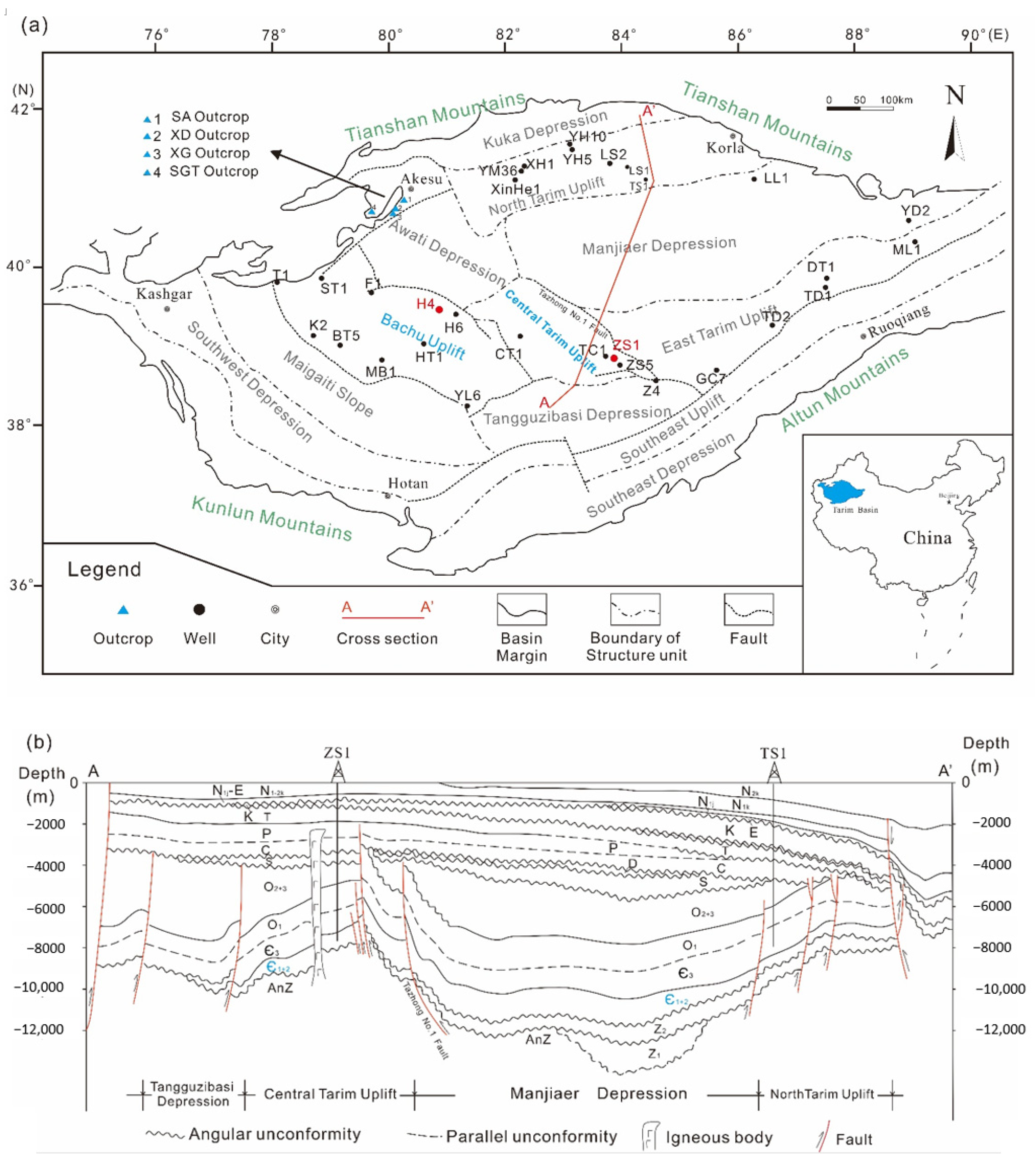
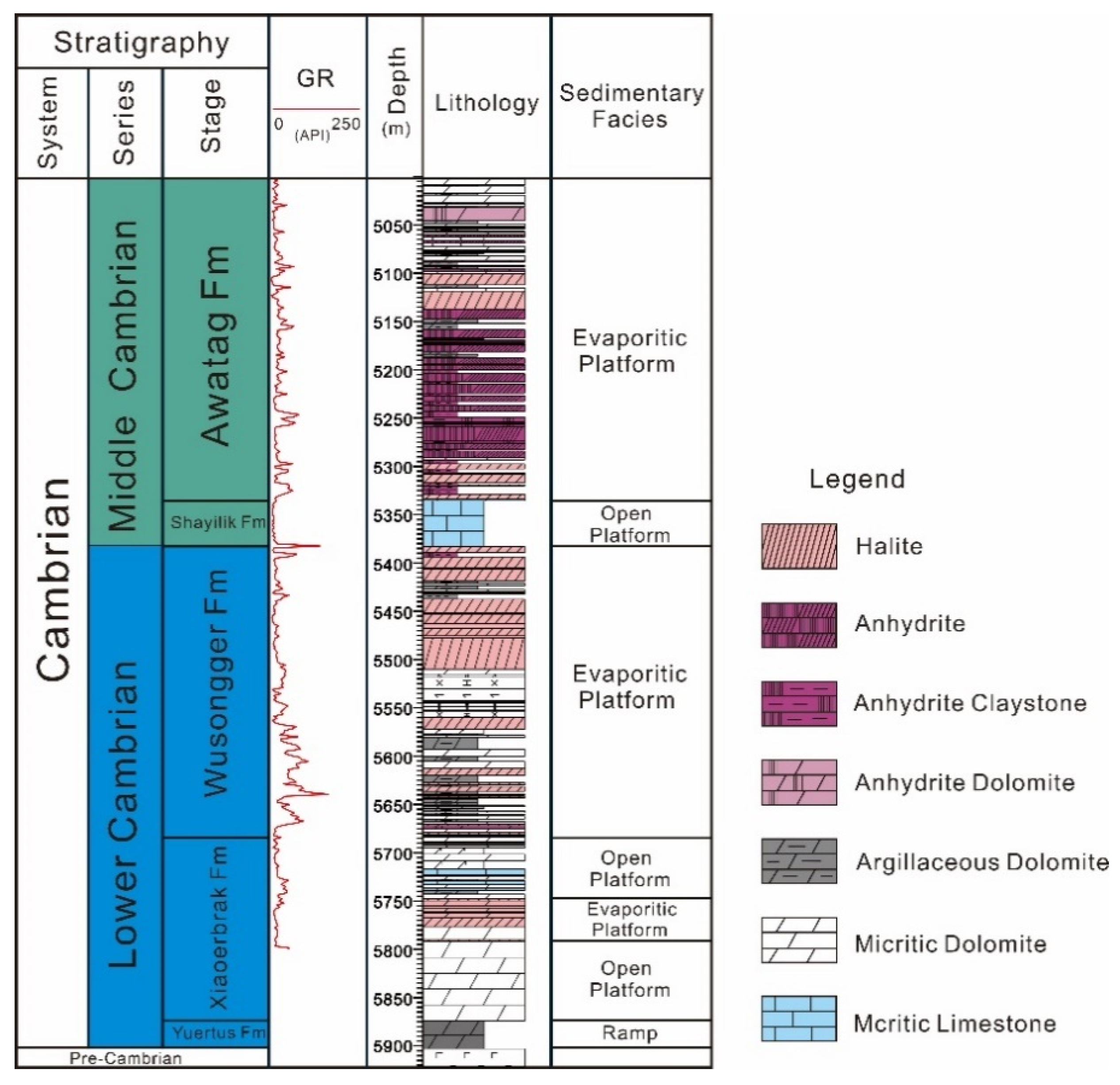



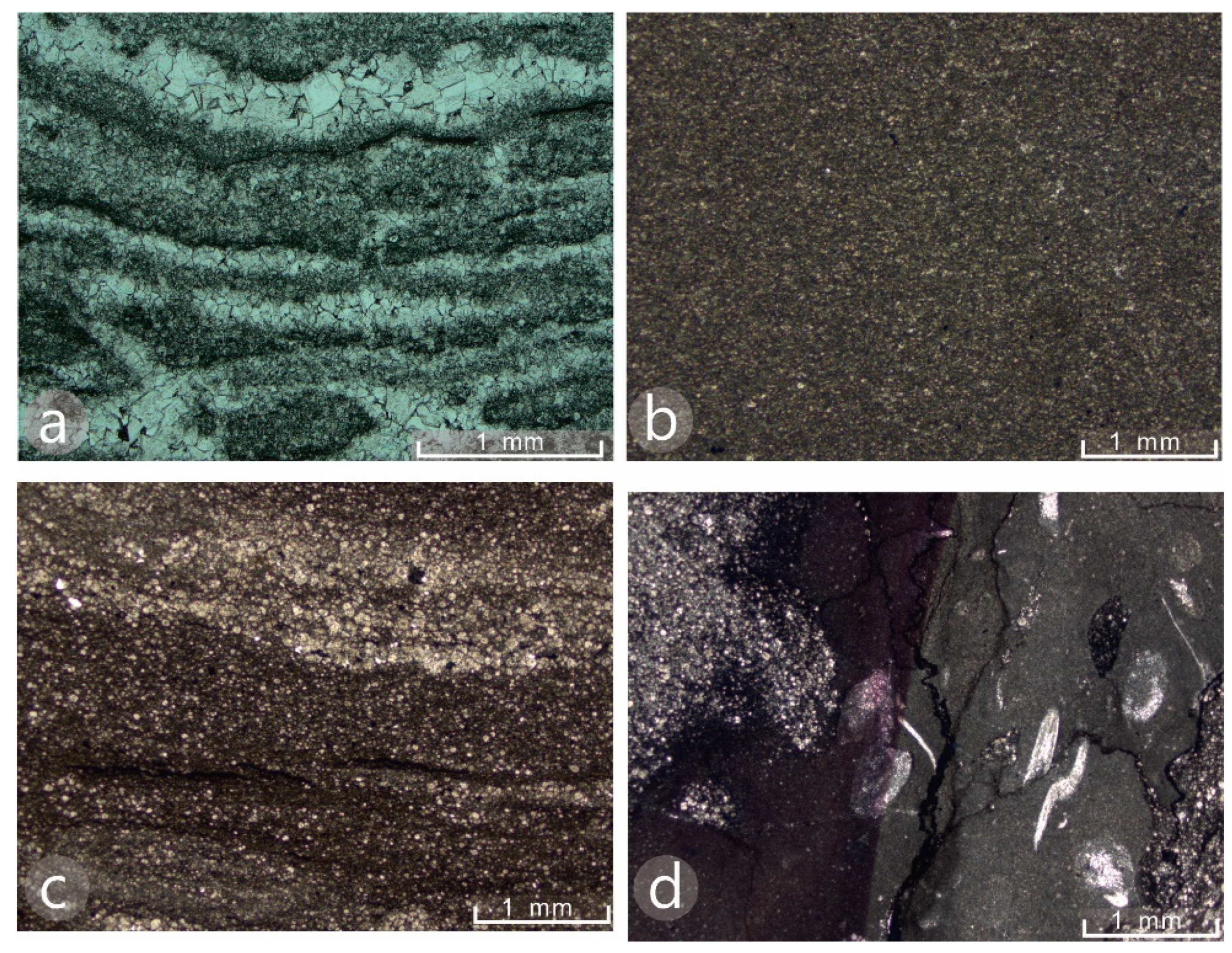
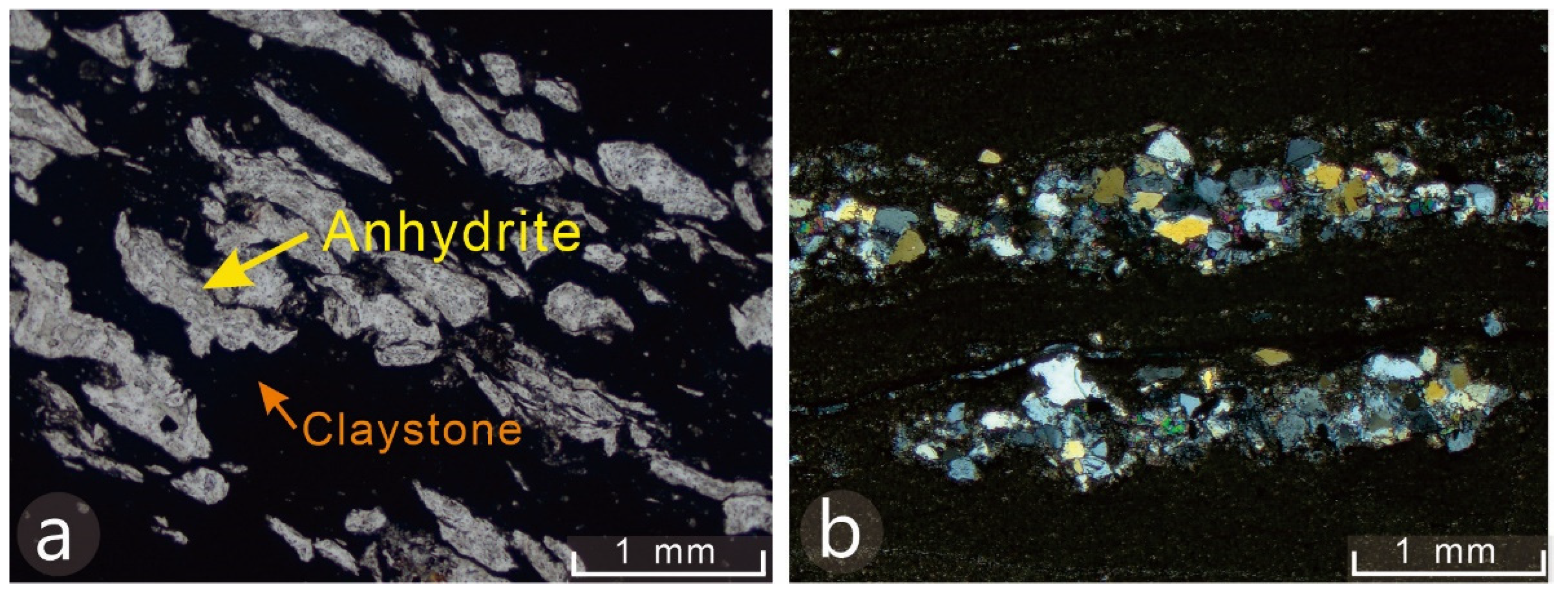
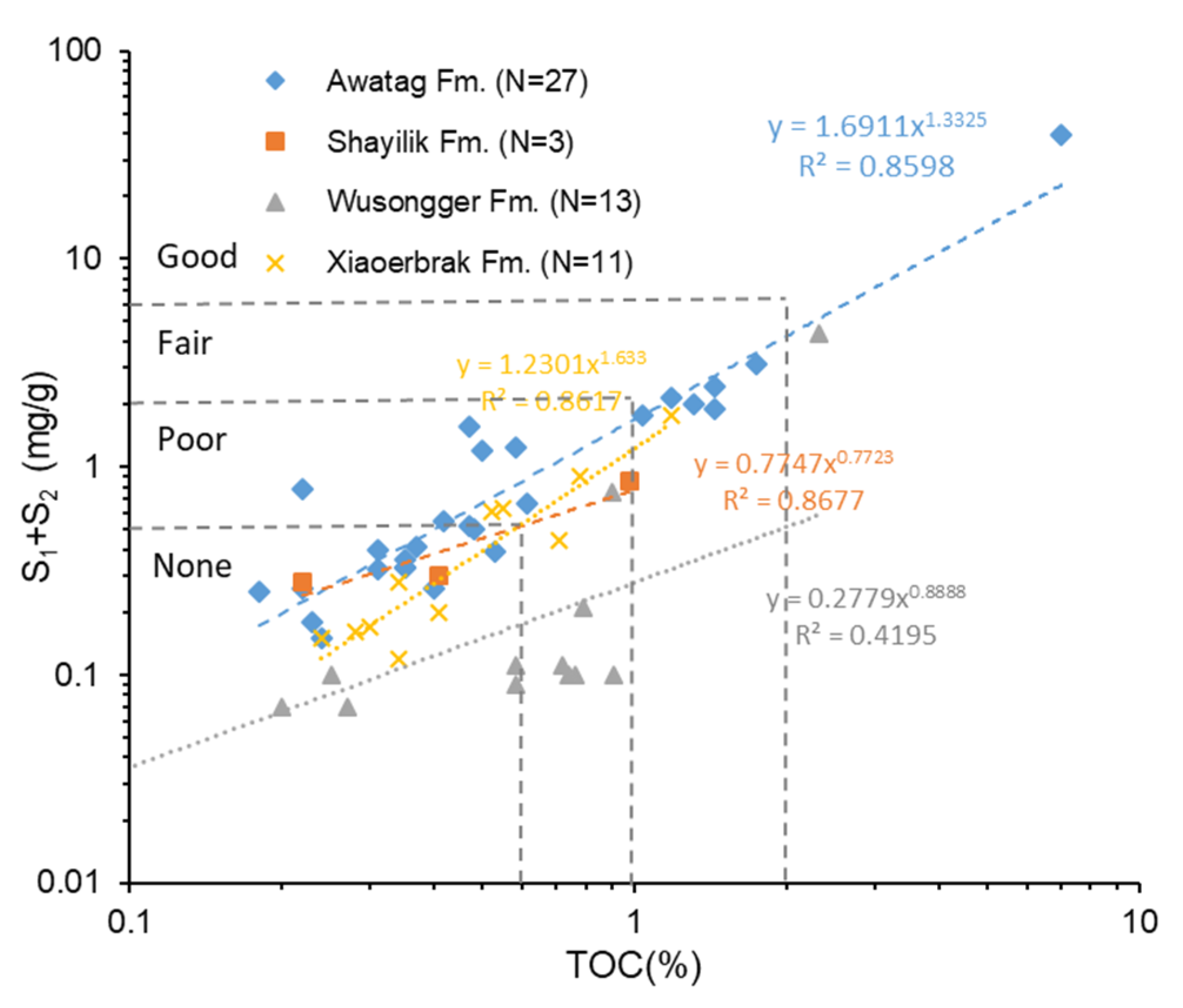
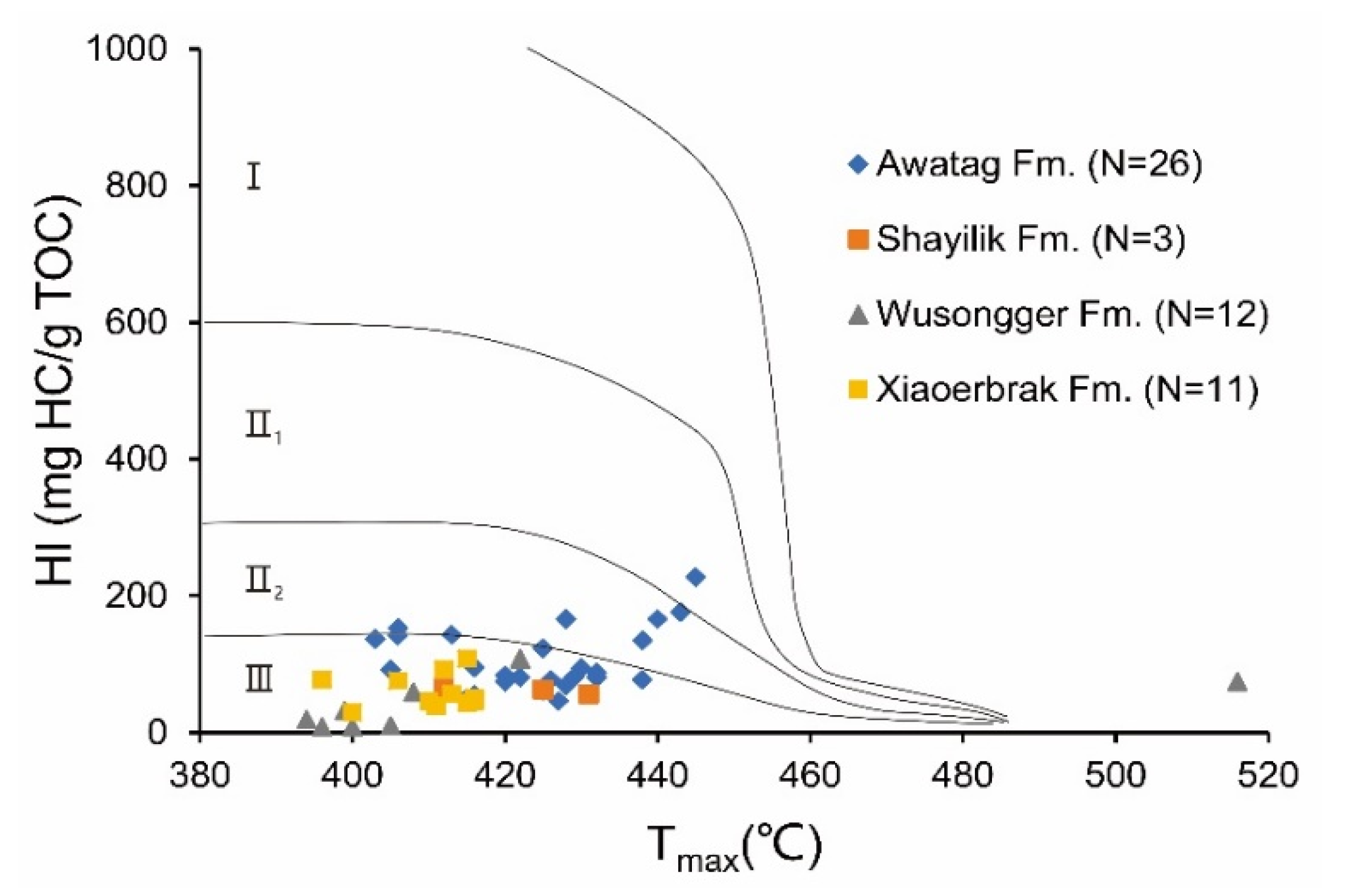
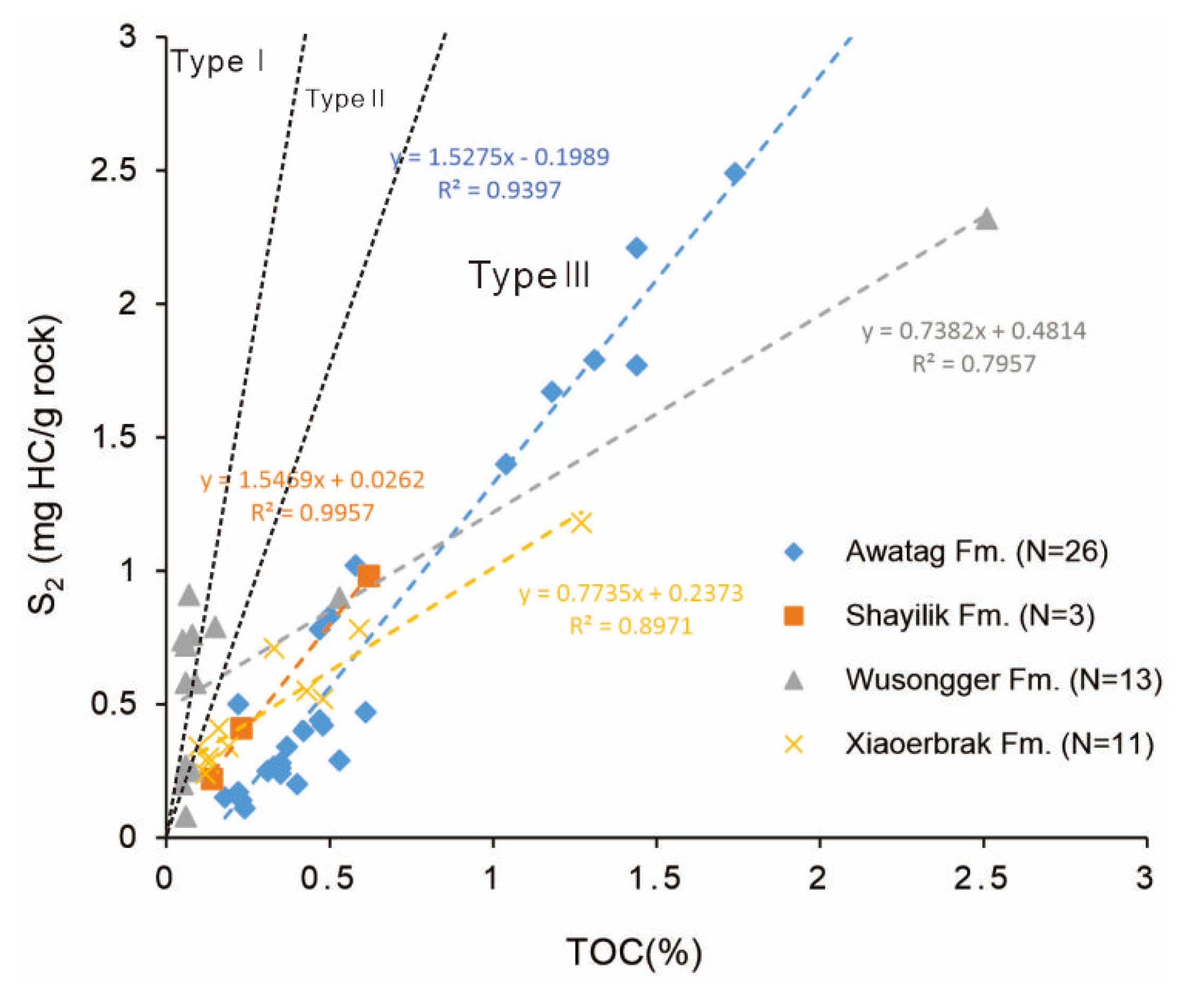

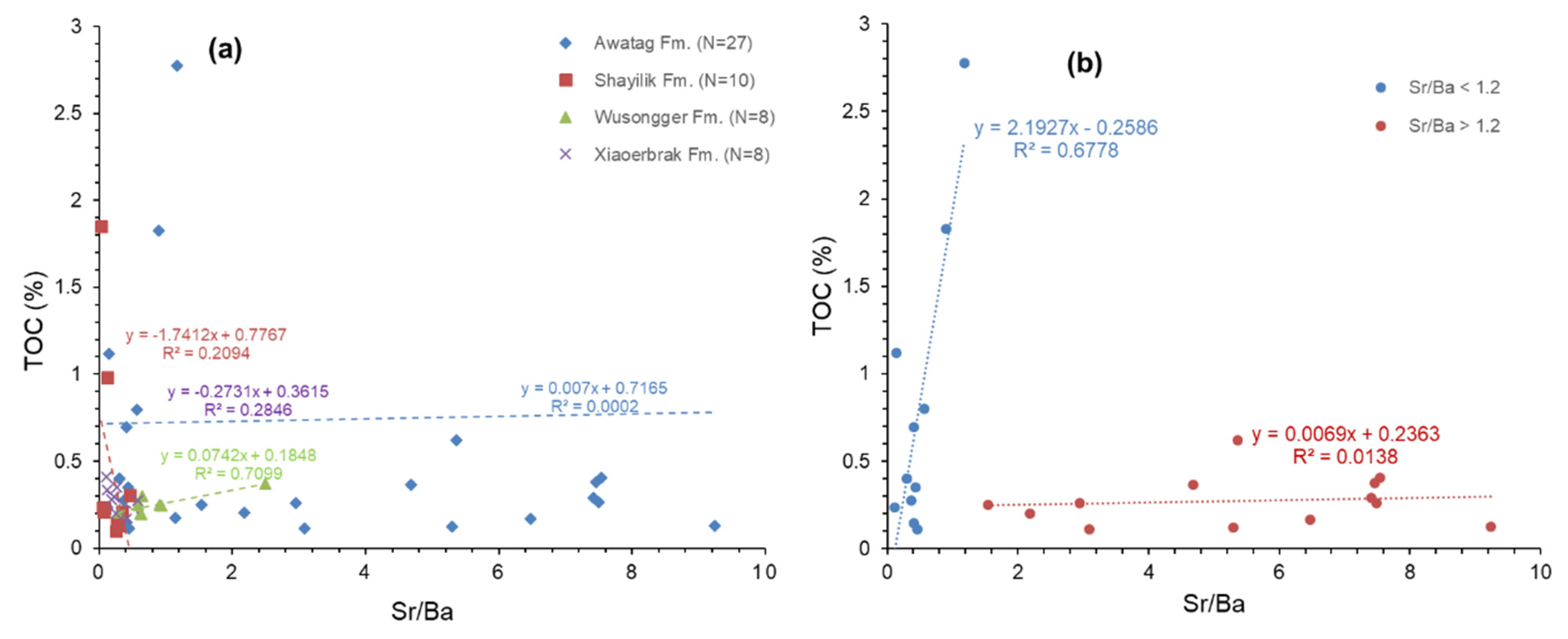
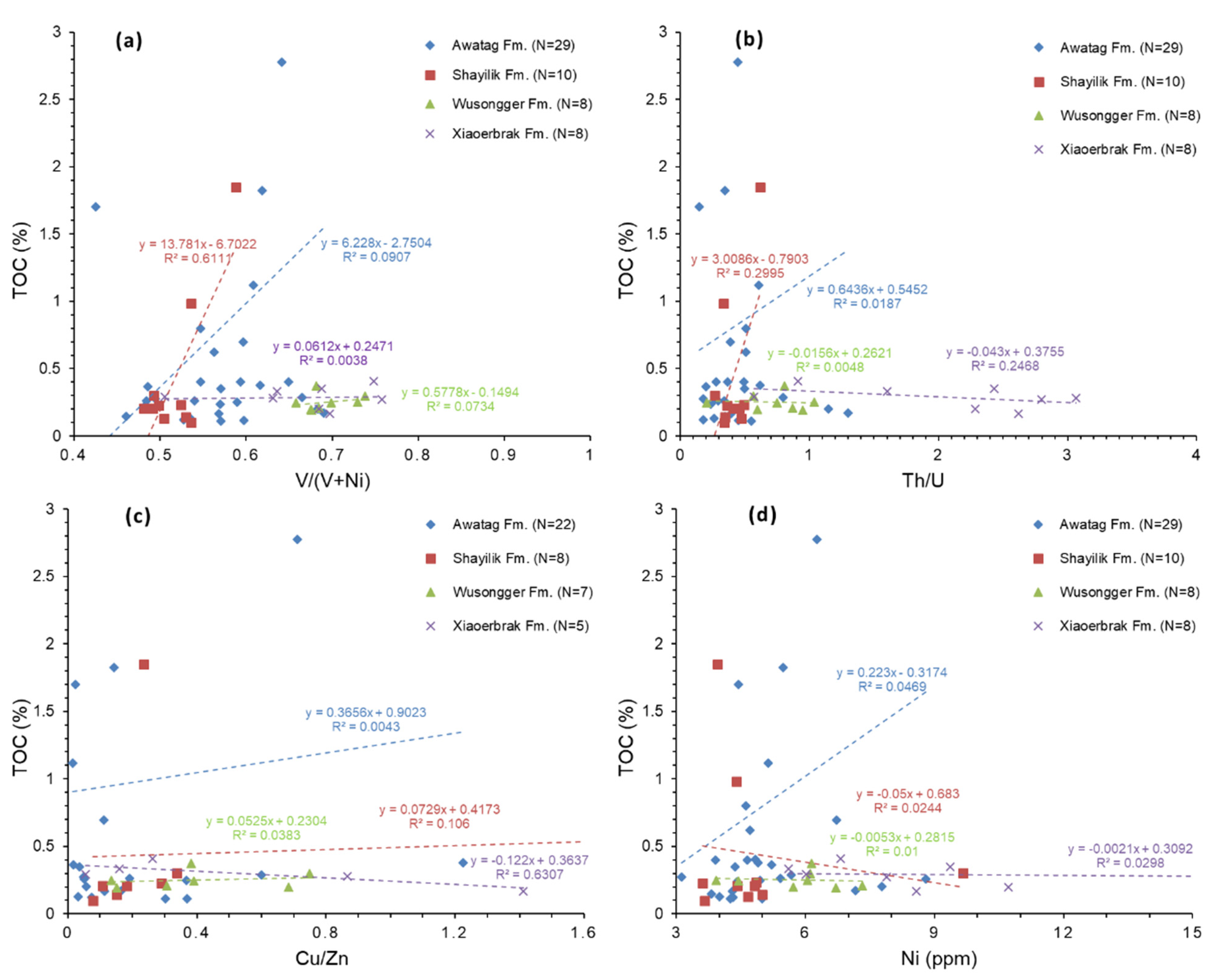
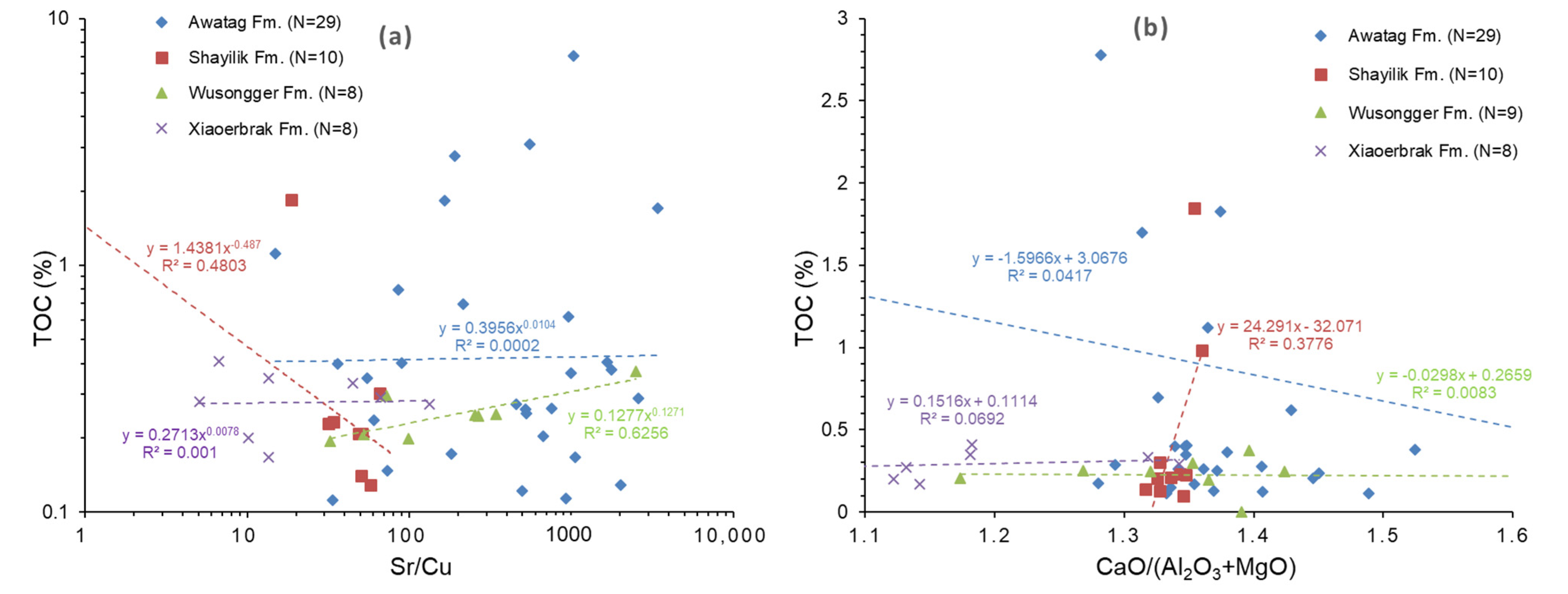
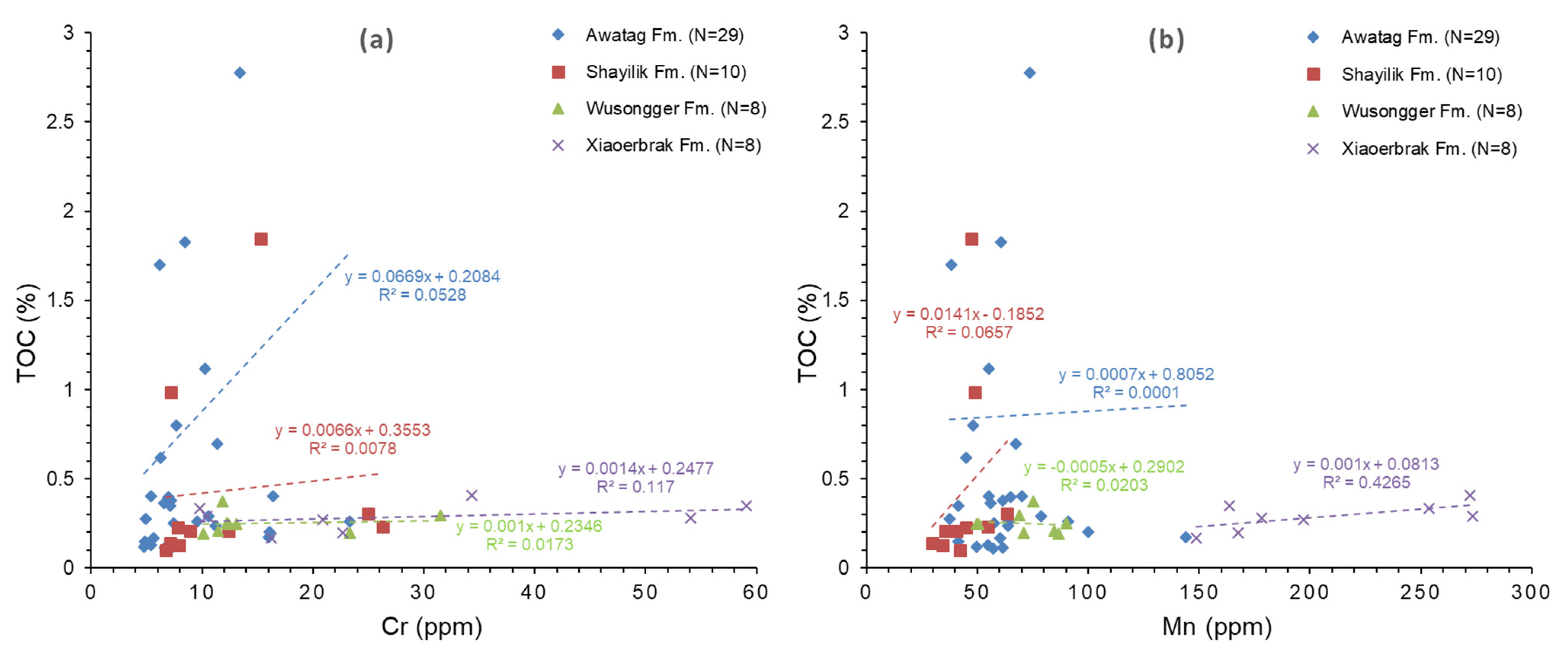
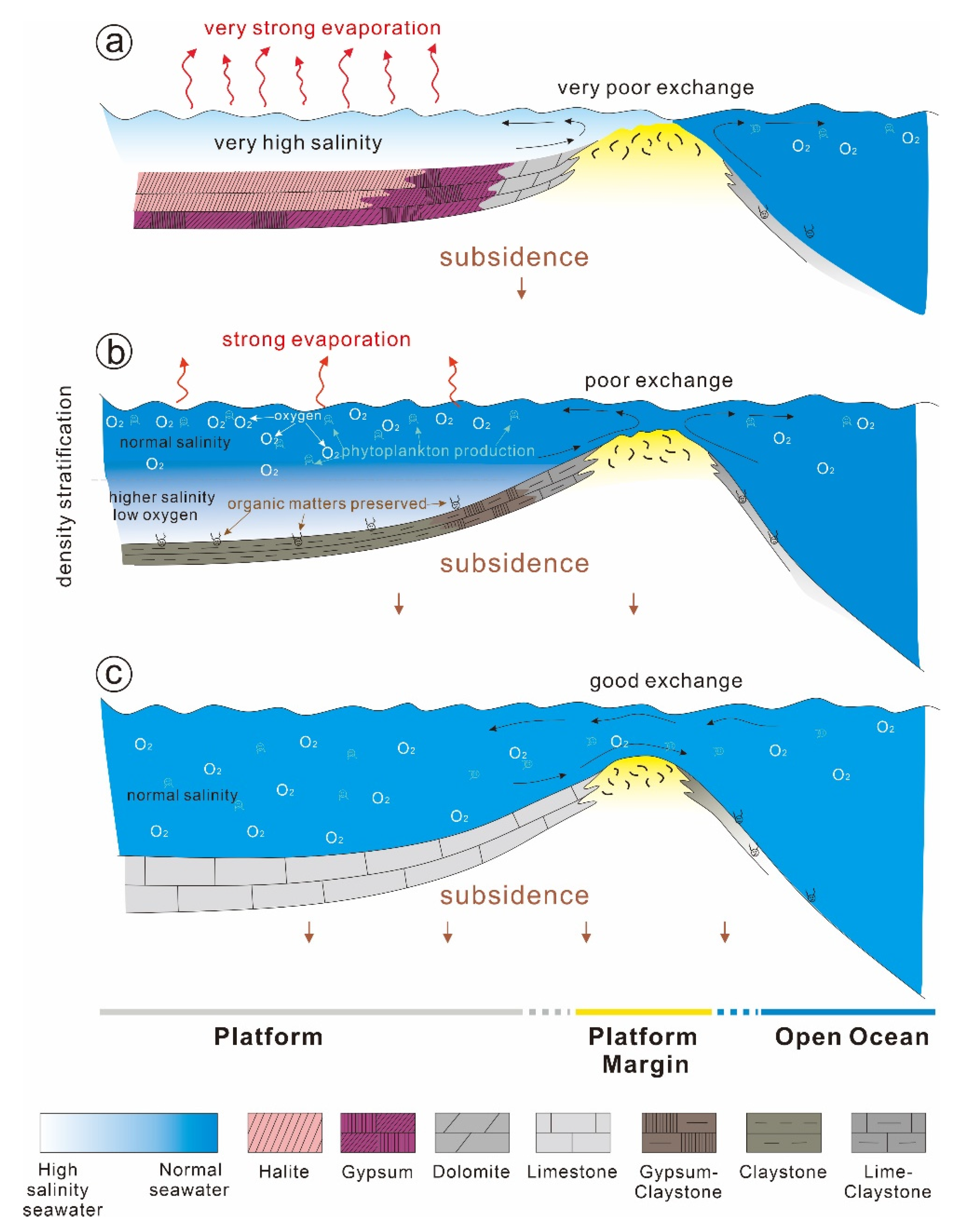
| No. | Depth | Formation | Lithology | TOC | Tmax | S1 | S2 | S1 + S2 | S3 | HI | OI |
|---|---|---|---|---|---|---|---|---|---|---|---|
| (m) | (%) | (°C) | (mg/g) | (mg/g) | (mg/g) | (mg/g) | (mg/g TOC) | (mg/g TOC) | |||
| 1 | 5025 | Є2a | micritic dolomite | 0.35 | 428 | 0.09 | 0.24 | 0.33 | 0.68 | 69 | 194 |
| 2 | 5035 | Є2a | micritic dolomite | 0.4 | 415 | 0.06 | 0.2 | 0.26 | 1.1 | 50 | 275 |
| 3 | 5045 | Є2a | micritic dolomite | 0.22 | 426 | 0.09 | 0.17 | 0.26 | 0.68 | 77 | 309 |
| 4 | 5055 | Є2a | micritic dolomite | 0.18 | 420 | 0.1 | 0.15 | 0.25 | 0.55 | 83 | 306 |
| 5 | 5065 | Є2a | anhydrite dolomite | 0.58 | 443 | 0.21 | 1.02 | 1.23 | 0.83 | 176 | 143 |
| 6 | 5075 | Є2a | anhydrite dolomite | 0.5 | 440 | 0.37 | 0.83 | 1.2 | 0.84 | 166 | 168 |
| 7 | 5085 | Є2a | micritic dolomite | 0.35 | 429 | 0.08 | 0.28 | 0.36 | 1.03 | 80 | 294 |
| 8 | 5095 | Є2a | micritic dolomite | 0.22 | 445 | 0.28 | 0.5 | 0.78 | 0.44 | 227 | 200 |
| 9 | 5105 | Є2a | micritic dolomite | 0.31 | 422 | 0.15 | 0.25 | 0.4 | 0.57 | 81 | 184 |
| 10 | 5115 | Є2a | micritic dolomite | 0.47 | 428 | 0.77 | 0.78 | 1.55 | 0.66 | 166 | 140 |
| 11 | 5135 | Є2a | micritic dolomite | 0.42 | 416 | 0.15 | 0.4 | 0.55 | 0.9 | 95 | 214 |
| 12 | 5145 | Є2a | anhydrite claystone | 1.44 | 406 | 0.22 | 2.21 | 2.43 | 5.73 | 153 | 398 |
| 13 | 5155 | Є2a | anhydrite claystone | 1.31 | 403 | 0.2 | 1.79 | 1.99 | 5.98 | 137 | 456 |
| 14 | 5165 | Є2a | anhydrite claystone | 1.44 | 425 | 0.14 | 1.77 | 1.91 | 5.03 | 123 | 349 |
| 15 | 5175 | Є2a | anhydrite dolomite | 0.24 | 427 | 0.04 | 0.11 | 0.15 | 0.73 | 46 | 304 |
| 16 | 5185 | Є2a | anhydrite dolomite | 0.35 | 420 | 0.07 | 0.26 | 0.33 | 1.15 | 74 | 329 |
| 17 | 5195 | Є2a | anhydrite dolomite | 0.47 | 430 | 0.08 | 0.44 | 0.52 | 1.54 | 94 | 328 |
| 18 | 5205 | Є2a | micritic dolomite | 0.37 | 405 | 0.07 | 0.34 | 0.41 | 1.34 | 92 | 362 |
| 19 | 5215 | Є2a | argillaceous dolomite | 1.74 | 413 | 0.63 | 2.49 | 3.12 | 3.88 | 143 | 223 |
| 20 | 5225 | Є2a | anhydrite dolomite | 1.18 | 406 | 0.48 | 1.67 | 2.15 | 2.57 | 142 | 218 |
| 21 | 5235 | Є2a | anhydrite claystone | 7 | / | 39.3 | 66.04 | 105.34 | 63.91 | 199 | 192 |
| 22 | 5245 | Є2a | anhydrite dolomite | 0.31 | 432 | 0.07 | 0.25 | 0.32 | 1.17 | 81 | 377 |
| 23 | 5255 | Є2a | anhydrite dolomite | 0.53 | 416 | 0.1 | 0.29 | 0.39 | 1.53 | 55 | 289 |
| 24 | 5265 | Є2a | anhydrite dolomite | 0.61 | 438 | 0.2 | 0.47 | 0.67 | 0.91 | 77 | 149 |
| 25 | 5275 | Є2a | anhydrite dolomite | 1.04 | 438 | 0.36 | 1.4 | 1.76 | 2 | 135 | 192 |
| 26 | 5285 | Є2a | anhydrite dolomite | 0.48 | 432 | 0.08 | 0.42 | 0.5 | 2.52 | 88 | 525 |
| 27 | 5295 | Є2a | micritic dolomite | 0.23 | 425 | 0.04 | 0.14 | 0.18 | 0.72 | 61 | 313 |
| 28 | 5345 | Є2s | micritic limestone | 0.98 | 425 | 0.23 | 0.62 | 0.85 | 2.85 | 63 | 291 |
| 29 | 5355 | Є2s | micritic limestone | 0.41 | 431 | 0.07 | 0.23 | 0.3 | 2.01 | 56 | 490 |
| 30 | 5375 | Є2s | micritic limestone | 0.22 | 412 | 0.14 | 0.14 | 0.28 | 0.55 | 64 | 250 |
| 31 | 5525 | Є1w | micritic dolomite | 0.2 | 607 | 0.02 | 0.05 | 0.07 | 0.56 | 25 | 280 |
| 32 | 5555 | Є1w | micritic dolomite | 0.08 | 516 | 0.03 | 0.06 | 0.09 | 0.91 | 75 | 1138 |
| 33 | 5575 | Є1w | anhydrite dolomite | 0.25 | 399 | 0.02 | 0.08 | 0.1 | 0.46 | 32 | 184 |
| 34 | 5585 | Є1w | micritic dolomite | 0.72 | 400 | 0.05 | 0.06 | 0.11 | 0.5 | 8 | 69 |
| 35 | 5595 | Є1w | micritic dolomite | 0.91 | 396 | 0.03 | 0.07 | 0.1 | 0.64 | 8 | 70 |
| 36 | 5605 | Є1w | micritic dolomite | 0.58 | 405 | 0.03 | 0.06 | 0.09 | 0.62 | 10 | 107 |
| 37 | 5615 | Є1w | micritic dolomite | 0.76 | / | 0.02 | 0.08 | 0.1 | 1 | 11 | 132 |
| 38 | 5625 | Є1w | micritic dolomite | 0.79 | 394 | 0.06 | 0.15 | 0.21 | 0.79 | 19 | 100 |
| 39 | 5635 | Є1w | micritic dolomite | 0.9 | 408 | 0.23 | 0.53 | 0.76 | 1.68 | 59 | 187 |
| 40 | 5645 | Є1w | micritic dolomite | 0.74 | 607 | 0.05 | 0.05 | 0.1 | 0.48 | 7 | 65 |
| 41 | 5655 | Є1w | micritic dolomite | 0.27 | 606 | 0.01 | 0.06 | 0.07 | 0.65 | 22 | 241 |
| 42 | 5665 | Є1w | micritic dolomite | 0.58 | 606 | 0.02 | 0.09 | 0.11 | 1.11 | 16 | 191 |
| 43 | 5675 | Є1w | argillaceous dolomite | 2.32 | 422 | 1.83 | 2.51 | 4.34 | 4.13 | 108 | 178 |
| 44 | 5685 | Є1x | micritic dolomite | 1.18 | 415 | 0.5 | 1.27 | 1.77 | 2.76 | 108 | 234 |
| 45 | 5695 | Є1x | micritic dolomite | 0.41 | 411 | 0.04 | 0.16 | 0.2 | 1.07 | 39 | 261 |
| 46 | 5705 | Є1x | micritic dolomite | 0.3 | 415 | 0.04 | 0.13 | 0.17 | 0.71 | 43 | 237 |
| 47 | 5715 | Є1x | micritic dolomite | 0.28 | 416 | 0.03 | 0.13 | 0.92 | 46 | 329 | |
| 48 | 5725 | Є1x | micritic dolomite | 0.24 | 416 | 0.03 | 0.12 | 0.15 | 0.69 | 50 | 288 |
| 49 | 5735 | Є1x | micritic dolomite | 0.34 | 400 | 0.02 | 0.1 | 0.12 | 0.63 | 29 | 185 |
| 50 | 5745 | Є1x | micritic dolomite | 0.34 | 413 | 0.09 | 0.19 | 0.28 | 0.65 | 56 | 191 |
| 51 | 5755 | Є1x | micritic dolomite | 0.71 | 410 | 0.11 | 0.33 | 0.44 | 0.95 | 46 | 134 |
| 52 | 5765 | Є1x | micritic dolomite | 0.55 | 396 | 0.2 | 0.43 | 0.63 | 1.36 | 78 | 247 |
| 53 | 5785 | Є1x | anhydrite dolomite | 0.78 | 406 | 0.31 | 0.59 | 0.9 | 1.03 | 76 | 132 |
| 54 | 5795 | Є1x | micritic dolomite | 0.52 | 412 | 0.13 | 0.48 | 0.61 | 1.24 | 92 | 238 |
| No. | Depth | Formation | Lithology | TOC | Al2O3 | MgO | CaO | V | Cr | Mn | Ni | Cu | Zn | Sr | Ba | Th | U | CaO/(Al2O3 +MgO) | V/(V+Ni) | Cu/Zn | Sr/Ba | Sr/Cu | Th/U |
|---|---|---|---|---|---|---|---|---|---|---|---|---|---|---|---|---|---|---|---|---|---|---|---|
| (m) | (%) | (%) | (%) | (%) | (ppm) | (ppm) | (ppm) | (ppm) | (ppm) | (ppm) | (ppm) | (ppm) | (ppm) | (ppm) | |||||||||
| 1 | 6217 | Є2a | argillaceous dolomite | 0.35 | 0.06 | 21.03 | 28.43 | 5.8 | 7.1 | 41.46 | 4.37 | 1.55 | 43.1 | 85.5 | 195 | 0.43 | 0.86 | 1.35 | 0.57 | 0.04 | 0.44 | 55 | 0.50 |
| 2 | 6227 | Є2a | stromatolite dolomite | 1.12 | 0.15 | 18.74 | 25.77 | 7.97 | 10.27 | 55.32 | 5.14 | 6.11 | 403 | 91.6 | 641 | 0.58 | 0.96 | 1.36 | 0.61 | 0.02 | 0.14 | 15 | 0.61 |
| 3 | 6237 | Є2a | very-fine crystalline dolomite | 0.8 | 0.02 | 15.11 | 33.9 | 5.57 | 7.66 | 47.96 | 4.61 | 1.26 | 108 | 191 | 0.41 | 0.8 | 2.24 | 0.55 | 0.57 | 86 | 0.51 | ||
| 4 | 6247 | Є2a | grain dolomite | 0.11 | 0.25 | 19.59 | 29.55 | 6.64 | 7.24 | 57.02 | 4.99 | 2.79 | 9.24 | 93.8 | 206 | 0.49 | 0.89 | 1.49 | 0.57 | 0.30 | 0.45 | 34 | 0.55 |
| 5 | 6257 | Є2a | micritic dolomite | 0.17 | 1.43 | 18.48 | 25.48 | 16 | 16.01 | 144.01 | 7.16 | 5.43 | 32.5 | 990 | 863 | 1.83 | 1.41 | 1.28 | 0.69 | 0.17 | 1.15 | 182 | 1.30 |
| 6 | 6267 | Є2a | stromatolite dolomite | 0.4 | 0.31 | 20.74 | 28.35 | 6.77 | 6.94 | 65.18 | 4.65 | 4.1 | 148 | 496 | 0.56 | 1.14 | 1.35 | 0.59 | 0.30 | 36 | 0.49 | ||
| 7 | 6277 | Є2a | stromatolite dolomite | 0.11 | 0.37 | 20.01 | 27.15 | 6.33 | 6.64 | 61.28 | 4.26 | 3.19 | 8.61 | 2947 | 954 | 0.54 | 1.2 | 1.33 | 0.60 | 0.37 | 3.09 | 925 | 0.45 |
| 8 | 6287 | Є2a | gypsum | 0.7 | 0.37 | 19.39 | 26.21 | 9.93 | 11.35 | 67.46 | 6.72 | 4.45 | 39.7 | 956 | 2315 | 0.63 | 1.64 | 1.33 | 0.60 | 0.11 | 0.41 | 215 | 0.39 |
| 9 | 6297 | Є2a | Ooid dolomite | 2.78 | 0.84 | 18.79 | 25.16 | 11.2 | 13.4 | 73.83 | 6.27 | 4.13 | 5.81 | 793 | 674 | 0.79 | 1.79 | 1.28 | 0.64 | 0.71 | 1.18 | 192 | 0.44 |
| 10 | 6307 | Є2a | grain dolomite | 0.26 | 0.16 | 19.37 | 26.58 | 8.26 | 23.33 | 91.04 | 8.8 | 3.6 | 71.4 | 1885 | 639 | 0.52 | 1.77 | 1.36 | 0.48 | 0.05 | 2.95 | 524 | 0.29 |
| 11 | 6317 | Є2a | gypsum dolomite | 0.26 | 0.23 | 20.63 | 27.99 | 6.35 | 9.59 | 64.10 | 5.41 | 3.35 | 17.5 | 2535 | 338 | 0.51 | 1.48 | 1.34 | 0.54 | 0.19 | 7.49 | 758 | 0.34 |
| 12 | 6327 | Є2a | grain dolomite | 7.06 | 0.34 | 16 | 21.09 | 9.97 | 10.98 | 59.06 | 5.36 | 3.27 | 14.1 | 3376 | 660 | 0.78 | 1.54 | 1.29 | 0.65 | 0.23 | 5.11 | 1032 | 0.50 |
| 13 | 6337 | Є2a | grain dolomite | 0.29 | 1.18 | 19.32 | 26.51 | 11.3 | 10.58 | 78.63 | 5.67 | 3.31 | 5.52 | 8618 | 1162 | 1.28 | 1.61 | 1.29 | 0.67 | 0.60 | 7.41 | 2600 | 0.80 |
| 14 | 6347 | Є2a | gypsum claystone | 0.13 | 0.2 | 19.77 | 27.34 | 4.61 | 5.41 | 54.81 | 4.01 | 1.29 | 40.0 | 2606 | 282 | 0.41 | 1.56 | 1.37 | 0.54 | 0.03 | 9.24 | 2023 | 0.26 |
| 15 | 6357 | Є2a | argillaceous dolomite | 0.17 | 0.37 | 19.69 | 27.16 | 5.67 | 5.66 | 60.42 | 4.31 | 3.09 | 27.4 | 3284 | 507 | 0.52 | 1.33 | 1.35 | 0.57 | 0.11 | 6.47 | 1063 | 0.39 |
| 16 | 6367 | Є2a | gypsum dolomite | 3.1 | 1.5 | 17.45 | 20.58 | 18.8 | 21.04 | 93.97 | 8.55 | 6.06 | 26.1 | 3358 | 699 | 2.2 | 1.76 | 1.09 | 0.69 | 0.23 | 4.80 | 554 | 1.25 |
| 17 | 6377 | Є2a | very-fine crystalline dolomite | 0.25 | 0.38 | 20 | 27.95 | 7.12 | 7.46 | 57.41 | 4.95 | 3.87 | 10.5 | 2044 | 1326 | 0.66 | 2.71 | 1.37 | 0.59 | 0.37 | 1.54 | 528 | 0.24 |
| 18 | 6387 | Є2a | grain dolomite | 0.37 | 20.49 | 28.28 | 4.92 | 6.6 | 55.88 | 5.21 | 1.51 | 90.3 | 1501 | 320 | 0.43 | 2.18 | 1.38 | 0.49 | 0.02 | 4.69 | 995 | 0.20 | |
| 19 | 6397 | Є2a | gypsum | 0.12 | 19.98 | 28.1 | 4.81 | 4.79 | 49.73 | 4.32 | 3.86 | 53 | 1931 | 364 | 0.35 | 1.99 | 1.41 | 0.53 | 0.07 | 5.30 | 500 | 0.18 | |
| 20 | 6407 | Є2a | micritic dolomite | 1.83 | 0.39 | 18.31 | 25.7 | 8.89 | 8.48 | 60.67 | 5.48 | 4.38 | 30.8 | 728 | 812 | 0.64 | 1.85 | 1.37 | 0.62 | 0.14 | 0.90 | 166 | 0.35 |
| 21 | 6417 | Є2a | gypsum dolomite | 0.62 | 0.07 | 19.12 | 27.42 | 6.07 | 6.28 | 44.96 | 4.72 | 2.44 | -1.32 | 2350 | 438 | 0.68 | 1.35 | 1.43 | 0.56 | 5.37 | 962 | 0.50 | |
| 22 | 6427 | Є2a | gypsum dolomite | 1.7 | 21.42 | 28.15 | 3.29 | 6.2 | 38.25 | 4.44 | 1.05 | 45.1 | 3586 | 347 | 0.2 | 1.4 | 1.31 | 0.43 | 0.02 | 10.32 | 3405 | 0.15 | |
| 23 | 6437 | Є2a | stromatolite dolomite | 0.27 | 20.66 | 29.05 | 3.05 | 4.93 | 37.49 | 3.12 | 2.76 | 57.6 | 1261 | 3465 | 0.22 | 1.25 | 1.41 | 0.49 | 0.05 | 0.36 | 457 | 0.18 | |
| 24 | 6447 | Є2a | argillaceous dolomite | 0.38 | 0.3 | 17.68 | 27.40 | 7.88 | 7.19 | 61.46 | 4.9 | 1.57 | 1.28 | 2779 | 372 | 0.89 | 1.44 | 1.52 | 0.62 | 1.22 | 7.46 | 1774 | 0.62 |
| 25 | 6457 | Є2a | gypsum dolomite | 0.40 | 0.38 | 20.41 | 28.04 | 8.95 | 16.44 | 70.27 | 4.84 | 1.85 | 3093 | 410 | 0.74 | 2.03 | 1.35 | 0.65 | 7.54 | 1669 | 0.37 | ||
| 26 | 6467 | Є2a | micritic dolomite | 0.15 | 0.02 | 22.38 | 29.92 | 3.26 | 4.84 | 41.24 | 3.81 | 1.29 | 95.3 | 234 | 0.16 | 0.45 | 1.34 | 0.46 | 0.41 | 74 | 0.35 | ||
| 27 | 6477 | Є2a | grain dolomite | 0.24 | 0.15 | 19.98 | 29.18 | 5.86 | 11.21 | 63.90 | 4.42 | 6.95 | 422 | 3594 | 0.39 | 1.66 | 1.45 | 0.57 | 0.12 | 61 | 0.24 | ||
| 28 | 6487 | Є2a | very-fine crystalline dolomite | 0.2 | 1.95 | 15.59 | 25.36 | 16.7 | 16.09 | 100.06 | 7.77 | 5.34 | 91.9 | 3565 | 1634 | 2 | 1.75 | 1.45 | 0.68 | 0.06 | 2.18 | 668 | 1.14 |
| 29 | 6497 | Є2a | gypsum dolomite | 0.4 | 0.06 | 21.38 | 28.72 | 4.71 | 5.36 | 55.33 | 3.9 | 1.19 | 107 | 353 | 0.3 | 1.07 | 1.34 | 0.55 | 0.30 | 90 | 0.28 | ||
| 30 | 6507 | Є2s | grain dolomite | 0.23 | 0 | 22.06 | 29.74 | 3.58 | 7.87 | 45.08 | 3.61 | 4.14 | 14.3 | 132 | 1728 | 0.17 | 0.48 | 1.35 | 0.50 | 0.29 | 0.08 | 32 | 0.36 |
| 31 | 6527 | Є2s | grain dolomite | 0.1 | 0.03 | 22.07 | 29.75 | 4.23 | 6.74 | 42.30 | 3.66 | 1.55 | 20.1 | 123 | 502 | 0.16 | 0.48 | 1.35 | 0.54 | 0.08 | 0.25 | 80 | 0.34 |
| 32 | 6537 | Є2s | gypsum dolomite | 0.23 | 0.03 | 22.08 | 29.7 | 5.34 | 26.28 | 54.75 | 4.85 | 4.1 | 139 | 2720 | 0.29 | 0.58 | 1.34 | 0.52 | 0.05 | 34 | 0.49 | ||
| 33 | 6547 | Є2s | stromatolite dolomite | 1.85 | 0.1 | 21.89 | 29.77 | 5.64 | 15.27 | 47.35 | 3.95 | 5.45 | 23.1 | 102 | 3895 | 0.19 | 0.31 | 1.35 | 0.59 | 0.24 | 0.03 | 19 | 0.62 |
| 34 | 6557 | Є2s | very-fine crystalline dolomite | 0.98 | 0.05 | 21.44 | 29.23 | 5.08 | 7.19 | 49.07 | 4.4 | 58 | 7.32 | 52.3 | 450 | 0.17 | 0.5 | 1.36 | 0.54 | 7.93 | 0.12 | 1 | 0.34 |
| 35 | 6567 | Є2s | grain dolomite | 0.21 | 0.11 | 22.24 | 29.86 | 4.47 | 12.41 | 40.59 | 4.82 | 1.61 | 15 | 78.4 | 1112 | 0.26 | 0.64 | 1.34 | 0.48 | 0.11 | 0.07 | 49 | 0.41 |
| 36 | 6577 | Є2s | grain dolomite | 0.21 | 0.07 | 22.41 | 29.8 | 4.25 | 8.93 | 35.63 | 4.41 | 1.49 | 8.15 | 76 | 219 | 0.23 | 0.5 | 1.33 | 0.49 | 0.18 | 0.35 | 51 | 0.45 |
| 37 | 6587 | Є2s | grain dolomite | 0.13 | 0.07 | 22.44 | 29.89 | 4.74 | 7.88 | 34.33 | 4.66 | 0.79 | 45.7 | 159 | 0.29 | 0.62 | 1.33 | 0.50 | 0.29 | 58 | 0.47 | ||
| 38 | 6597 | Є2s | grain dolomite | 0.14 | 0.08 | 22.45 | 29.66 | 5.62 | 7.11 | 29.45 | 4.99 | 1.08 | 7.08 | 54.7 | 202 | 0.31 | 0.89 | 1.32 | 0.53 | 0.15 | 0.27 | 51 | 0.34 |
| 39 | 6607 | Є2s | gypsum dolomite | 0.3 | 0.12 | 22.08 | 29.47 | 9.39 | 24.99 | 63.56 | 9.66 | 11.9 | 35.1 | 786 | 1722 | 0.58 | 2.18 | 1.33 | 0.49 | 0.34 | 0.46 | 66 | 0.27 |
| 40 | 6617 | Є1w | gypsum dolomite | 0.24 | 0.45 | 18.97 | 27.65 | 8.55 | 12.42 | 50.53 | 4.45 | 3.9 | 9.99 | 1048 | 1116 | 0.37 | 1.81 | 1.42 | 0.66 | 0.39 | 0.94 | 269 | 0.20 |
| 41 | 6627 | Є1w | gypsum dolomite | 0.37 | 0.18 | 20.26 | 28.54 | 13.1 | 11.87 | 75.16 | 6.14 | 2.97 | 7.76 | 7408 | 2980 | 1.53 | 1.9 | 1.4 | 0.68 | 0.38 | 2.49 | 2493 | 0.81 |
| 42 | 6637 | Є1w | gypsum dolomite | 0.2 | 1.11 | 11.18 | 27.37 | 11.9 | 23.3 | 70.87 | 5.71 | 7.48 | 10.9 | 740 | 1202 | 1.06 | 1.77 | 2.23 | 0.68 | 0.68 | 0.62 | 99 | 0.60 |
| 43 | 6647 | Є1w | fine crystalline dolomite | 0 | 0.73 | 19.14 | 27.64 | 1.39 | |||||||||||||||
| 44 | 6657 | Є1w | very-fine crystalline dolomite | 0.30 | 0.35 | 18.79 | 25.89 | 17.2 | 31.51 | 69.10 | 6.1 | 9.99 | 13.3 | 725 | 1113 | 1.01 | 1.78 | 1.35 | 0.74 | 0.75 | 0.65 | 73 | 0.57 |
| 45 | 6667 | Є1w | argillaceous dolomite | 0.25 | 0.8 | 19.97 | 27.41 | 9.09 | 13.11 | 49.49 | 3.92 | 3.44 | 875 | 961 | 1.09 | 1.46 | 1.32 | 0.70 | 0.91 | 254 | 0.75 | ||
| 46 | 6687 | Є1w | gypsum dolomite | 0.25 | 1.02 | 20.16 | 26.86 | 16.3 | 12.21 | 89.96 | 6.05 | 5.85 | 43.1 | 2001 | 3475 | 1.79 | 1.73 | 1.27 | 0.73 | 0.14 | 0.58 | 342 | 1.03 |
| 47 | 6697 | Є1w | argillaceous dolomite | 0.19 | 1.21 | 18.02 | 26.26 | 14 | 10.09 | 86.74 | 6.71 | 5.23 | 34.5 | 170 | 269 | 2.17 | 2.29 | 1.37 | 0.68 | 0.15 | 0.63 | 32 | 0.95 |
| 48 | 6707 | Є1w | argillaceous dolomite | 0.21 | 1.59 | 19.27 | 24.48 | 15.9 | 11.47 | 84.62 | 7.33 | 4.95 | 16.2 | 261 | 848 | 2.17 | 2.49 | 1.17 | 0.68 | 0.31 | 0.31 | 53 | 0.87 |
| 49 | 6717 | Є1x | stromatolite dolomite | 0.28 | 5.98 | 13.31 | 17.3 | 43.7 | 54.08 | 178.32 | 25.5 | 19.1 | 22 | 97.2 | 509 | 7.01 | 2.29 | 0.9 | 0.63 | 0.87 | 0.19 | 5 | 3.06 |
| 50 | 6727 | Є1x | very-fine crystalline dolomite | 0.17 | 3.1 | 18.21 | 24.34 | 19.8 | 16.29 | 148.72 | 8.57 | 4.71 | 3.34 | 63.6 | 157 | 3.04 | 1.16 | 1.14 | 0.70 | 1.41 | 0.40 | 14 | 2.62 |
| 51 | 6737 | Є1x | grain dolomite | 0.35 | 2.42 | 18.52 | 24.73 | 20.6 | 59.09 | 163.81 | 9.36 | 3.98 | 54.2 | 208 | 2.73 | 1.12 | 1.18 | 0.69 | 0.26 | 14 | 2.43 | ||
| 52 | 6747 | Є1x | stromatolite dolomite | 0.2 | 3.28 | 17.86 | 23.72 | 23.3 | 22.7 | 167.44 | 10.7 | 5.63 | 57.1 | 223 | 3.67 | 1.61 | 1.12 | 0.68 | 0.26 | 10 | 2.28 | ||
| 53 | 6777 | Є1x | grain dolomite | 0.27 | 3.15 | 17.10 | 22.92 | 24.7 | 20.87 | 197.25 | 7.89 | 4.49 | 599 | 1039 | 4.05 | 1.45 | 1.13 | 0.76 | 0.58 | 133 | 2.80 | ||
| 54 | 6787 | Є1x | grain dolomite | 0.33 | 0.6 | 20.84 | 28.27 | 9.79 | 10 | 253.67 | 5.61 | 1.69 | 10.6 | 75.9 | 604 | 1.07 | 0.67 | 1.32 | 0.64 | 0.16 | 0.13 | 45 | 1.60 |
| 55 | 6797 | Є1x | grain dolomite | 0.29 | 0.04 | 21.37 | 28.74 | 6.16 | 10.4 | 273.33 | 6.02 | 1.21 | 22 | 80.5 | 355 | 0.53 | 0.93 | 1.34 | 0.51 | 0.06 | 0.23 | 66 | 0.57 |
| 56 | 6807 | Є1x | micritic dolomite | 0.41 | 2.68 | 18.55 | 25.11 | 20.3 | 34.36 | 272.17 | 6.82 | 6.66 | 25.3 | 44.5 | 394 | 1.47 | 1.62 | 1.18 | 0.75 | 0.26 | 0.11 | 7 | 0.91 |
Publisher’s Note: MDPI stays neutral with regard to jurisdictional claims in published maps and institutional affiliations. |
© 2021 by the authors. Licensee MDPI, Basel, Switzerland. This article is an open access article distributed under the terms and conditions of the Creative Commons Attribution (CC BY) license (https://creativecommons.org/licenses/by/4.0/).
Share and Cite
Wei, M.; Bao, Z.; Munnecke, A.; Liu, W.; Harrison, G.W.M.; Zhang, H.; Zhang, D.; Li, Z.; Xu, X.; Lu, K.; et al. Paleoenvironment of the Lower–Middle Cambrian Evaporite Series in the Tarim Basin and Its Impact on the Organic Matter Enrichment of Shallow Water Source Rocks. Minerals 2021, 11, 659. https://doi.org/10.3390/min11070659
Wei M, Bao Z, Munnecke A, Liu W, Harrison GWM, Zhang H, Zhang D, Li Z, Xu X, Lu K, et al. Paleoenvironment of the Lower–Middle Cambrian Evaporite Series in the Tarim Basin and Its Impact on the Organic Matter Enrichment of Shallow Water Source Rocks. Minerals. 2021; 11(7):659. https://doi.org/10.3390/min11070659
Chicago/Turabian StyleWei, Mingyang, Zhidong Bao, Axel Munnecke, Wei Liu, G. William M. Harrison, Hua Zhang, Demin Zhang, Zongfeng Li, Xiting Xu, Kai Lu, and et al. 2021. "Paleoenvironment of the Lower–Middle Cambrian Evaporite Series in the Tarim Basin and Its Impact on the Organic Matter Enrichment of Shallow Water Source Rocks" Minerals 11, no. 7: 659. https://doi.org/10.3390/min11070659
APA StyleWei, M., Bao, Z., Munnecke, A., Liu, W., Harrison, G. W. M., Zhang, H., Zhang, D., Li, Z., Xu, X., Lu, K., & Shen, Z. (2021). Paleoenvironment of the Lower–Middle Cambrian Evaporite Series in the Tarim Basin and Its Impact on the Organic Matter Enrichment of Shallow Water Source Rocks. Minerals, 11(7), 659. https://doi.org/10.3390/min11070659







